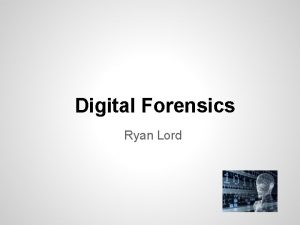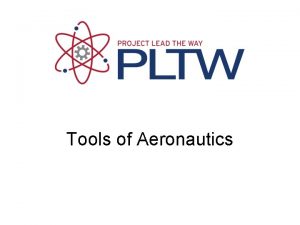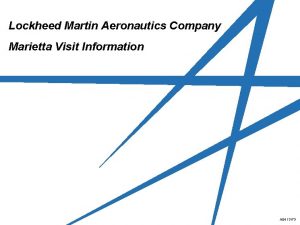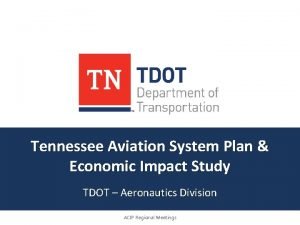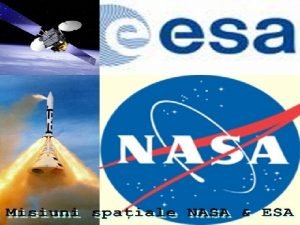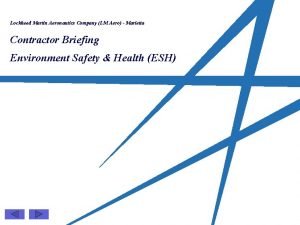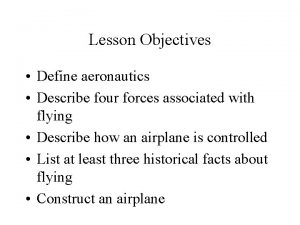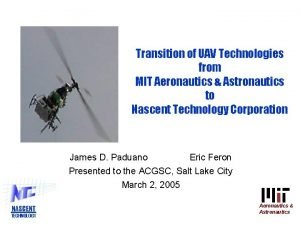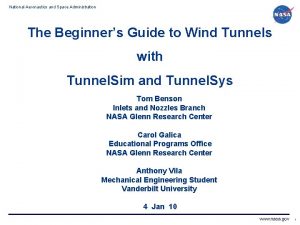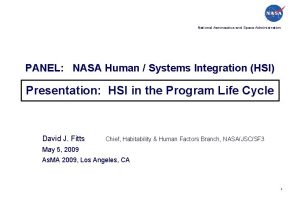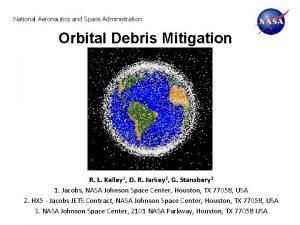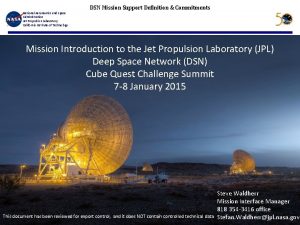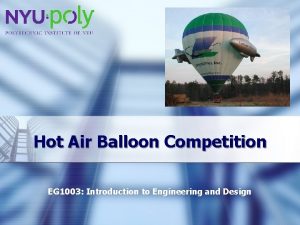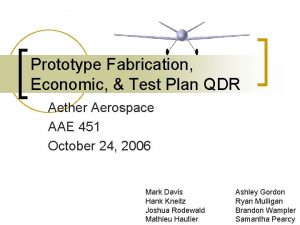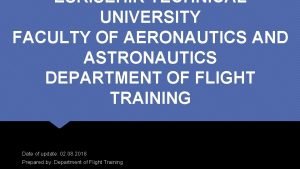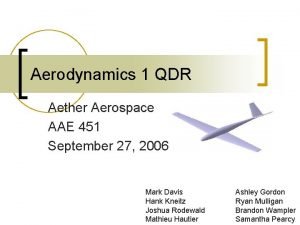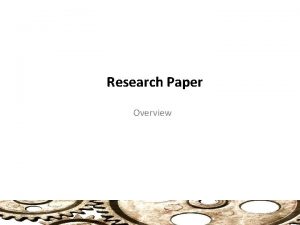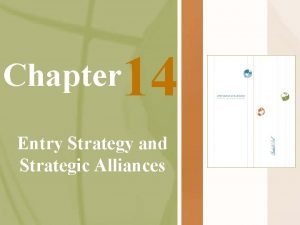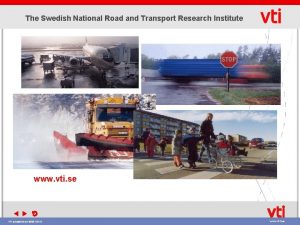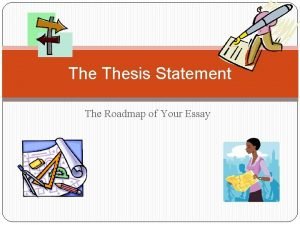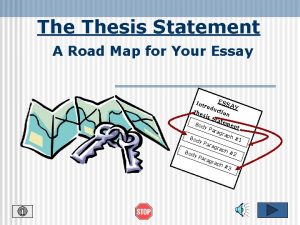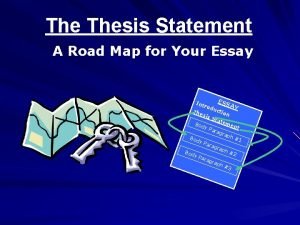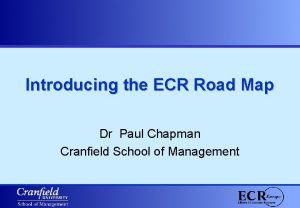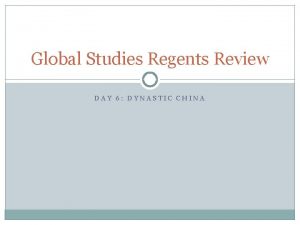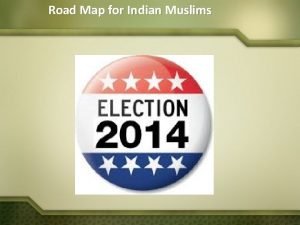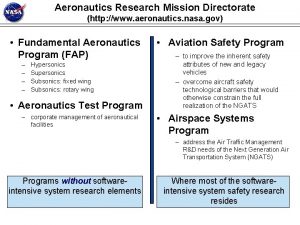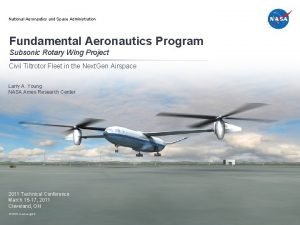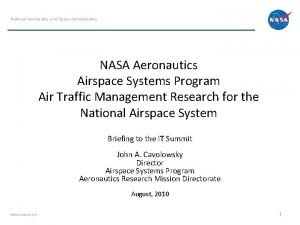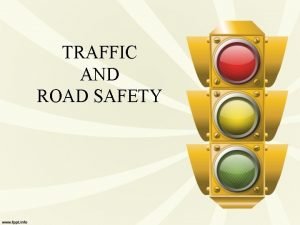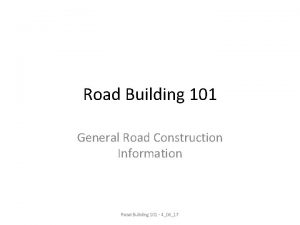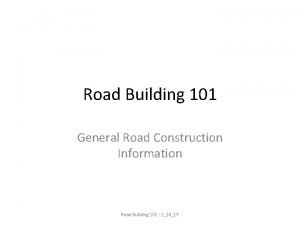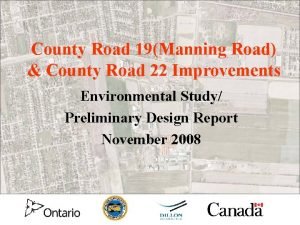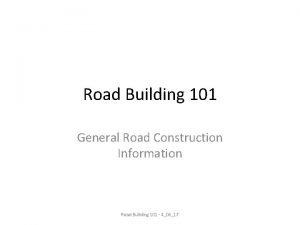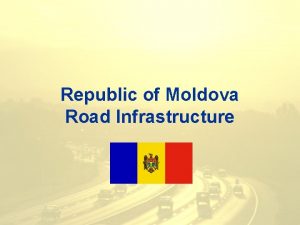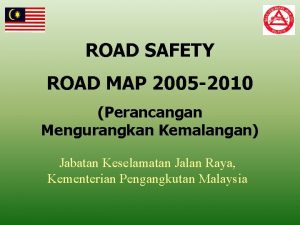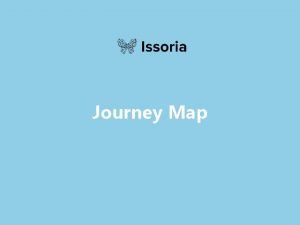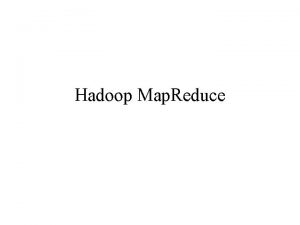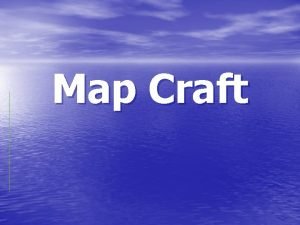Aeronautics Research Strategic Road Map Overview May 3































- Slides: 31

Aeronautics Research Strategic Road Map Overview May 3, 2005 Terrence J. Hertz Deputy Associate Administrator for Technology Aeronautics Research Mission Directorate 5/3/05 050503 ARAC Roadmaps. ppt

Outline • • 5/3/05 Agency Road Map Planning & Development Processes Aeronautics Road Map Baseline Aeronautics Road Map Development Interim Road Maps 050503 ARAC Roadmaps. ppt 1

NASA Advanced Planning Activities Commission recommendations framework National Goals and Objectives Strategic Roadmaps And Architectures * Human Capital and Infrastructure Needs Capability Roadmaps * Thirteen strategic roadmaps to be developed over the next year 5/3/05 050503 ARAC Roadmaps. ppt 2

National Goals and Objectives NASA’s overarching Agency Goal is the fundamental goal of the Vision for Space Exploration: • Advance U. S. scientific, security, and economic interests through a robust space exploration program. NASA’s Guiding National Objectives • Implement a sustained and affordable human and robotic program to explore the solar system and beyond. • Extend human presence across the solar system, starting with a human return to the Moon by the year 2020, in preparation for human exploration of Mars and other destinations. • Develop the innovative technologies, knowledge, and infrastructures both to explore and to support decisions about the destinations for human exploration. • Promote international and commercial participation in exploration to further U. S. scientific, security, and economic interests. • Study the Earth system from space and develop new space-based and related capabilities for this purpose. 5/3/05 050503 ARAC Roadmaps. ppt 3

NASA Strategic Objectives for 2005 & Beyond 1. Undertake robotic and human lunar exploration to further science and to develop and test new approaches, techno-logies, and systems to enable and support sustained human and robotic exploration of Mars and more distant destina-tions. The first robotic mission will be no later than 2008. 2. Conduct robotic exploration of Mars to search for evidence of life, to understand the history of the solar system, and to prepare for future human exploration. 3. Conduct robotic exploration across the solar system for scientific purposes and to support human exploration. In particular, explore the moons of Jupiter, asteroids, and other bodies to search for evidence of life, to understand the history of the solar system, and to search for resources. 4. Conduct advanced telescope searches for Earth-like planets and habitable environments around the stars. 5. Explore the universe to understand its origin, structure, evolution, and destiny. 6. Return the Space Shuttle to flight and focus its use on completion of the International Space Station, complete assembly of the ISS, and retire the Space Shuttle in 2010, following completion of its role in ISS assembly. Conduct ISS activities consistent with U. S. obligations to ISS partners. 7. Develop a new crew exploration vehicle to provide crew transportation for missions beyond low Earth orbit. First test flight to be by the end of this decade, with operational capability for human exploration no later than 2014. 8. Focus research and use of the ISS on supporting space exploration goals, with emphasis on understanding how the space environment affects human health and capabilities, and developing countermeasures. 9. Conduct the first extended human expedition to the lunar surface as early as 2015, but no later than 2020. 10. Conduct human expeditions to Mars after acquiring adequate knowledge about the planet using robotic missions and after successfully demonstrating sustained human exploration missions to the Moon. 11. Develop and demonstrate power generation, propulsion, life support, and other key capabilities required to support more distant, more capable, and/or longer duration human and robotic exploration of Mars and other destinations. 12. Provide advanced aeronautical technologies to meet the challenges of next generation systems in aviation, for civilian and scientific purposes, in our atmosphere and in atmospheres of other worlds. 13. Use NASA missions and other activities to inspire and motivate the Nation’s students and teachers, to engage and educate the public, and to advance the scientific and technological capabilities of the nation. 14. Advance scientific knowledge of the Earth system through space -based observation, assimilation of new observations, and development and deployment of enabling technologies, systems, and capabilities, including those with the potential to improve future operational systems. 15. Explore the Sun–Earth system to understand the Sun and its effects on Earth, the solar system, and the space environmental conditions that will be experienced by human explorers, and demonstrate technologies that can improve future operational systems. 16. Pursue opportunities for international participation to support U. S. space exploration goals. 17. Pursue commercial opportunities for providing transportation and other services supporting International Space Station and exploration missions beyond Earth orbit. Separate to the maximum extent practical crew from cargo. 18. Use U. S. commercial space capabilities and services to fulfill NASA requirements to the maximum extent practical and continue to involve, or increase the involvement of, the U. S. private sector in design and development of space systems. 12. Provide advanced aeronautical technologies to meet the challenges of next generation systems in aviation, for civilian and scientific purposes, in our atmosphere and in atmospheres of other worlds. 5/3/05 050503 ARAC Roadmaps. ppt 4

Agency Strategic Roadmaps Tri - Chairs Roadmap Directorate 1. Robotic and human lunar expeditions Center External Steidle / Readdy Howell T. Stafford 2. Sustained, long-term robotic and human exploration of Mars Diaz Elachi T. Young 3. Sustained program of solar system exploration Figueroa Hubbard J. Lunine 4. Advanced telescope searches for Earth-like planets and habitable environments Asrar Bleichman A. Burrows 5. Develop an exploration transportation system Steidle Kennedy C. Bolden 6. Complete assembly of the International Space Station and focus utilization Uhran Cabana T. Betterton 7. Safely transition from Space Shuttle to new explorationfocused launch systems* Deferred* 8. Explore the origin, evolution, structure, and destiny of the Universe Kinney White K. Flanagan DOD Participation 5/3/05 * Leverages off Integrated Space Operations Summit, (ISOS) process until RTF 050503 ARAC Roadmaps. ppt 5

Agency Strategic Roadmaps (cont. ) Tri - Chairs Roadmap 9. Directorate Determine how living Earth system is affected by internal dynamics, and understand implications for life Center External Figueroa Evans C. Kennel 10. Explore Sun-Earth system to understand effects on Earth and implications for human exploration Diaz Einaudi T. Killeen 11. Transform air transportation and enable the next generation of atmospheric vehicles Hertz N/A J. Jamieson 12. Educate students and public, and expand national technical skills and capabilities Loston Earls TBD 13. Comprehensive national plan for utilization of nuclear systems Steidle Scolese J. Ahearne DOD Participation 5/3/05 050503 ARAC Roadmaps. ppt 6

Capability Roadmaps Capability NASA chair External chair Coordinators Directorate APIO High-energy power and propulsion J. Nainiger (GRC) Tom Hughes (Penn State University) Overall – B. Park Technical – R. Taylor P. Bankston (JPL) In-space transportation P. Mc. Connaughey (MSFC) Col. Joe Boyles (USAF SMC) Overall – B. Park Technical – G. Lyles T. Inman (MSFC) Advanced telescopes and observatories L. Feinberg (GSFC) Howard Mac. Ewan (NRO) H. Thronson D. Coulter (JPL) Communication and navigation R. Spearing Mike Regan (NSSO) T. Cremins M. Gates S. Mecherle (Innocept) Robotic access to planetary surfaces M. Adler (JPL) Robert Braun (Georgia Tech) H. Thronson C. Ruoff (JPL) Human planetary landing systems R. Manning (JPL) Harrison Schmitt Overall – B. Park Technical – J. Trosper R. Mueller (KSC) Human health and support systems D. Grounds (JSC) Al Boehm (Ret, Hamilton Sunstrand) Overall – B. Park Technical – G. Trinh J. Aikins (ARC) Human exploration systems and mobility C. Culbert (JSC) Geoff Taylor Overall – B. Park Technical – J. Mankins T. Inman (MSFC) DOD Participation 5/3/05 050503 ARAC Roadmaps. ppt 7

Capability Roadmaps (cont. ) Capability NASA chair Autonomous systems and robotics S. Zornetzer (ARC) Transformational spaceport/range K. Poniatowski (HQ) Scientific instruments/sensors R. Barney (GSFC) In situ resource utilization External chair Doug Gage (DARPA ret) Coordinators Directorate APIO H. Thronson J. Aikins (ARC) T. Cremins, M. Gates D. Skelly (KSC) Maria Zuber (MIT) H. Thronson P. Bankston (JPL) J. Sanders (JSC) Mike Duke (Colorado School of Mines) Overall – B. Park Technical – J. Mankins R. Mueller (KSC) Advanced modeling, simulation, analysis E. Antonsson (JPL) Warren Washington (NCAR) H. Thronson J. Aikins (ARC) Systems engineering cost/risk analysis S. Cavanaugh (La. RC) Alan Wilhite/ Georgia Institute of Technology Overall – B. Park Technical – V. Hwa V. Regenie (DFRC) Nanotechnology M. Hirschbein (HQ) Minoo Dastoor Dimitris Lagoudas (Texas A&M) H. Thronson J. Crooke (GSFC) DOD Participation 5/3/05 050503 ARAC Roadmaps. ppt 8

Aeronautics Research Objectives Protect Air Travelers and the Public Decrease the aircraft fatal accident rate, reduce the vulnerability of the air transportation system to hostile threats, and mitigate the consequences of accidents and hostile acts. Protect the Environment Protect local and global environmental quality by reducing aircraft noise and emissions. Increase Mobility Enable more people and goods to travel faster and farther, with fewer delays. Partnership for National Security Enhance the Nation’s security through [aeronautical] partnerships with Do. D, DHS, and other U. S. or international government agencies. Explore Revolutionary Aeronautical Concepts Create novel aeronautical concepts and technology to support science missions and terrestrial and space applications. 5/3/05 050503 ARAC Roadmaps. ppt 9

Aeronautics Research Priorities and Programs Programmatic Priorities Ensure NASA contribution to Joint Planning & Development Office (JPDO) Emphasize public good research Enhance uninhabited aerial vehicles (UAV) research Assess possibilities for supersonics Increase planetary aircraft research Determine if there is a requirement to continue hypersonics research Programs Aviation Safety & Security 5/3/05 Airspace Systems 050503 ARAC Roadmaps. ppt Vehicle Systems 10

Vehicle Systems Program Strategic Technical Focus Areas Environmentally Friendly, Clean Burning Engines — Develop innovative technologies to enable intelligent turbine engines with significantly reduced harmful emissions while maintaining high performance and increasing reliability New Aircraft Energy Sources and Management — Investigate new energy sources and intelligent management techniques for zero emissions and enable new vehicle concepts for public mobility and new science missions Quiet Aircraft for Community Friendly Service — Develop airframe and engine noise reduction technology and operational concepts to bring objectionable noise within the airport boundary Aerodynamic Performance for Fuel Efficiency & Community Access — Improve aerodynamic efficiency, structures and materials technologies, and design tools and methodologies to reduce fuel burn and minimize environmental impact and enable new vehicle concepts and capabilities for public mobility and new science missions 5/3/05 050503 ARAC Roadmaps. ppt 11

Vehicle Systems Program Strategic Technical Focus Areas (cont. ) Aircraft Weight Reduction and Durability — Develop ultralight smart materials and structures, aerodynamic concepts, and lightweight subsystems to enable advanced configurations for public mobility, high altitude long endurance vehicles, and planetary aircraft Smart Aircraft and Autonomous Control — Enable aircraft to fly with reduced or no human intervention, to optimize flight over multiple regimes, and to provide maintenance on demand towards the goal of a feeling, seeing, sensing, sentient air vehicle Flight and System Demonstrations — Mature and validate new aircraft capabilities in relevant flight environment in partnership with industry and other government agencies Strategic Technical Directions — Gather data and perform strategic analysis to provide guidance on future program directions 5/3/05 050503 ARAC Roadmaps. ppt 12

Airspace Systems Program Strategic Technical Focus Areas Efficient Traffic Flow — Improving the efficiency of individual aircraft operating within the National Airspace System (NAS) System–Wide Operations Technologies — Efficient operation of the NAS as an overall Nationwide system with global interaction Airspace Human Factors — Human interaction, performance and reliability in the design of complex airspace systems 5/3/05 050503 ARAC Roadmaps. ppt 13

Aviation Safety & Security Program Strategic Technical Focus Areas Aircraft Self-Protection & Preservation — Protect and prevent damage to aircraft due to abnormal operations and system failures through advances in airborne-based technologies Hostile Act Intervention & Protection — Increase resiliency of the air traffic system against threats and hostile acts by providing technologies to identify and mitigate potential vulnerabilities Human Error Avoidance & Mitigation — Prevent unsafe flight situations due to breakdown between human and machine interface and promote optimal flight-crew performance, workload allocation, and situational awareness Environmental Hazards Awareness & Mitigation — Detect and/or eliminate the effects of natural hazards that could compromise safe ATS operation by reducing the role of atmospheric conditions in aviation fatal accidents, incidents, and injuries System Vulnerability Discovery & Management — Identify and inform users of potential ATS vulnerabilities by providing a system-wide safety-risk assessment capability that is accessible to and actively utilized by key stakeholders in the ATS 5/3/05 050503 ARAC Roadmaps. ppt 14

Strategic Road Map Development Phase I Process January 2005 – May 2005 APIO 2 Interim Aeronautics Technologies Strategic Road Maps 1997 Strategic Road Maps (Baseline) Chicago Strategic Road Map FACA Committee Review - Scope - Goals - Objectives Updated Expert 1 Estimates on Capabilities: - Cost - Performance - Impact/Benefits - Schedule - Risk - Dependencies - Constraints 1. Various Reports, and Program and Center Experts 5/3/05 2. Advanced Planning and Integration Office Utility Function Test Workshop - Safety - Security - Capacity - Emissions & Noise - Leadership Portfolio Analysis - Optimizations - Sensitivity Analysis 050503 ARAC Roadmaps. ppt Strategic Road Maps for ARAC Subcommittee Review May 26 th & 27 th 15

Strategic Road Map Development Planned Phase II Process May 2005 – Ongoing Expert Estimates on Capabilities: - Cost - Schedule - Risk - Non JPDO 1 Performance/Impacts Revised NASA Internal Strategic Road Maps National Utility Function Workshop - Safety - Security - Capacity - Emissions & Noise - Leadership 5/3/05 1. Joint Planning and Development Office National Policy Institute of Inputs Aerospace Official Report Portfolio Analysis JPDO - Optimizations - Sensitivity Analysis NASA - Optimizations - Sensitivity Analysis Evaluation & Analysis Simulations: - Impact/Benefits - Dependencies - Constraints 050503 ARAC Roadmaps. ppt Integrated JPDO Strategic Road Maps and Non JPDO NASA Unique Road Maps 16

5/3/05 DRAFT Aeronautical 050503 Technologies Strategic Road Maps ARAC Roadmaps. ppt 17

Baseline 1997 Roadmaps System Information Systems Safety Security 5/3/05 050503 ARAC Roadmaps. ppt

APIO Time Frame Achievements/Enabling Capabilities Phase I — 2005 - 2015 Digital Era – Network Enabled Optimizations for State-of-the-Art Systems • Automation enhancements of business-as-usual-operations • Global integration of existing sensors for real-time global situational awareness (security, safety, capacity) • Evolutionary reductions of emissions and noise for current So. A systems • Highly accurate predictive systems (safety, security, capacity, environment, aircraft/infrastructure systems) for real-time human decision support systems • Operational High Altitude, Long Endurance UAV’s; Prototypes for autonomous cargo, firefighting, rescue, & other missions • Robust Hypersonic and Quiet Supersonic Operations Demonstrators • Evolutionary Low/Zero Emission Power Density & Storage improvements • Simulation autopsies & analysis of security and safety hazards/failures 5/3/05 050503 ARAC Roadmaps. ppt 19

APIO Time Frame Achievements/Enabling Capabilities Phase II — 2015 - 2025 Sentient Era – Pro-Active, Reconfigurable Systems for New and Enhanced Capabilities • System level automation with controlled zones of autonomous operations • Integration of next generation global sensors and communications for prospective situational awareness – seamless national defense integration • Micro and Nano structure, power, and control surface enhancements enabling new vehicle classes and augmentation to existing vehicle fleets • Semi-reconfigurable pro-active/on demand systems (safety, security, capacity, environment, subsystems (intelligent engines, gate robotics & intelligent maintenance systems ) • Inclement weather proof systems • Revolutionary Zero Emission Power Density & Storage capabilities • Total elimination of some emission classes and significant reductions in noise • Seamless NAS UAV fleet operations for a range of missions with controlled zones of autonomous operations • Regular hypersonic and supersonic operations with seamless integration involving military and as appropriate launch operations • Embedded, multi-fault tolerant security and safety systems including self maintenance and repair 5/3/05 050503 ARAC Roadmaps. ppt 20

APIO Time Frame Achievements/Enabling Capabilities Phase III — 2025 - 2035 Nano-Bio Era – Revolutionary Systems for Human Societal Evolution • Highly distributed with dynamic real-time system & vehicle optimizations • Collaborative autonomous systems (no human labor) for commercial, private multi-modal transportation and UAV operations • Regenerative and highly reconfigurable hybrid organic structures and systems for real-time optimization, hazard avoidance, and security threat mitigations • Total elimination of direct, unwanted emissions and noise • Ubiquitous, robust sensor nets & communications • Micro Travel – individual flight gear/suits for local urban, neighborhood & nature hike type excursions as well as entertainment & construction/operations type activities 5/3/05 050503 ARAC Roadmaps. ppt 21

Safety Fatal accident rate vs. 1990 -96: 2005 Aircraft selfprotection & preservation Environmental hazards awareness & mitigation ▼-50% ▼-70% 2010 2015 ▼-90% 2020 • Large scale homeland security • Global/Seamless Security/Do. D integration & Do. D Integration 2025 ▼-98% 2030 2035 • Advanced Bio/Nano Personal Protection Systems • Re-active risk mitigation systems • Pro-active risk mitigation systems based on that mitigate abnormal operations risk pre-cursor identification • Re-active risk mitigation systems that • Real-time Learning/Adaptive • Highly Reconfiguration mitigate system failures Risk Mitigation Systems • Detection of natural hazards that compromise safe operations in the National Airspace System • Impervious to Natural Environment Hazards • Mitigation of the effects of detected natural hazards • Highly Robust Materials Systems through real-time in-flight self healing & repairing systems that compromise safe operations in the NAS Resistant to Environmental Hazards • Recovery from Unsafe flight situations due to Human error avoidance human error • Recovery from Unsafe flight situations due to human/machine interface breakdown • Onboard Autonomous Advisor – Electronic Co-pilot • Recovery from Unsafe flight situations due to machine error Digital Era 5/3/05 • System-Wide Autonomous Advisor – Sentient NAS Sentient Era 050503 ARAC Roadmaps. ppt Nano-Bio Era 22

Security Reduction in vulnerabilities: 2005 ▼-35% 2010 ▼-60% 2015 ▼-90% 2020 2025 ▼-99% 2030 2035 • Protection of critical assets from hostile aircraft takeovers • Protection from MANPADS, other projectiles, • &&explosivedevices Hostile act intervention & protection • Protection from EME/cyber attacks • Protection of aircraft systems for information flow against hostile disruption • Isolation, Containment, & Elimination of communicable diseases, chemical & biological agents on-board aircraft and airports System vulnerability discovery & management • Detection & mitigation of deviations from flight • path with hostile intent • Discovery of potential security breachesat atairports – Intelligent Sensors – Self replication sensor grids • Data mining & detection of potential cargothreat potential cargo • Sensing of communicable diseases, chemical & & biological agents on-board aircraft and airports Digital Era 5/3/05 Sentient Era 050503 ARAC Roadmaps. ppt Nano-Bio Era 23

Environment NOx emissions vs. 1996: CO 2 emissions vs. 1996: Noise vs. 1997: 2005 ▼-70% ▼-25% ▼-10 d. B ▼-80% ▼-35% ▼-20 d. B 2010 2015 2020 2025 ▼Zero emissions, virtually silent aircraft 2030 2035 • Low-emission subsonic vehicles Reduced aircraft emissions • Low-emission supersonic vehicles • Low-emission extreme short takeoff & landing vehicles • Low-emission personal air vehicles • Electronically driven, • hydrogen powered vehicles • Lightweight structure for • Low-emission rotorcraft low power requirements (30%) • Active airframe surface response and air flow control (inlets, boundary layer, jet exhaust, etc. ) for aerodynamic efficiency & acoustic suppression • Low-emission unmanned aerial vehicles • Low-noise subsonic vehicles Reduced aircraft noise • Low-noise supersonic vehicles • Low-noise extreme short takeoff & landing vehicles • Low-noise personal air vehicles • Low-noise rotorcraft • Low-noise unmanned aerial vehicles Sentient Era 5/3/05 050503 ARAC Roadmaps. ppt Nano-Bio Era 24

Capacity ATS capacity vs. 1997: 2005 Efficient traffic flow ▼ 2. 05 (x 1997) 2010 ▼ 2. 5 (x 1997) 2015 2020 ▼ 3 (x 1997) 2025 2030 ▼ 4 (x 1997) 2035 • Increase en-route commercial operations in the NAS • Full system capability for general aviation during peak demand • Full system capability public service aircraft during peak demand Systemwide operations • Minimize system-wide disruptions from external events (thunderstorms, etc) • Harmonize equipment and operations globally • Increase arrival & landing rates at commercial airports Aircraft/ airport productivity • More commercial operations from small and underused airports • Commercial operations with short or no runways • Automated optimization of 4 -D flight path for all commercial aircraft Fully integrated automated optimized NAS • Transparent integration of general aviation, public services, & UAVs • ATM procedures tailored to individual aircraft characteristics • High level optimization of system performance & full integration of en route & terminal op’ns • System impervious to disruptions from any source Digital Era 5/3/05 Sentient Era 050503 ARAC Roadmaps. ppt Nano-Bio Era 25

Mobility Goal: Continuously expanding choice of efficient air transportation 2005 2010 2015 2020 2025 2030 2035 • Efficient subsonic vehicles Optimized flight with reduced or no human intervention • Efficient low-boom supersonic vehicles • ATM for UAV’s & Other vehicle types (supersonics/hypersonics) Micro Travel – Individual flight gear/suites for local neighborhood/urban/entertainment excursions • Quiet & efficient all-weather extreme short takeoff & landing vehicles • Highly configurable subsystems for continuous optimizations through entire flight profile • Real-time transformation systems for continuous • Efficient all-weather rotorcraft • Low cost, efficient, easy-to-fly personal • Autonomous Personal Air Vehicles • Reconfigurable Personal Multi-Modal Modular Vehicles optimizations through the entire flight profile air vehicles Optimized ground ops and maintenance with reduced or no human intervention • Highly accurate predictive decision support systems for human operations Digital Era 5/3/05 • Intelligent, Pro-active Maintenance Support • Self Healing & Regenerative Systems Sentient Era 050503 ARAC Roadmaps. ppt Nano-Bio Era 26

New Missions 2005 2010 2015 2020 2025 2030 2035 ▼ 14 days @ 60, 000 ft w/200 kg payload ▼ 100 days @ 60, 000 ft w/150 kg payload ▼ 100 days @ 60, 000 ft w/3, 000 kg payload Autonomous longendurance unmanned flight • Autonomous, high altitude long-endurance unmanned aerialvehicletechnologies • Planetary flight vehicle technologies • Innovative applications of autonomous unmanned Robust Re-useable Demonstration Vehicles & Systems Operational Vehicles ▼ ▼ Hypersonic atmospheric flight • System R&D for Propulsion and vehicle options for Next Generation Operational Vehicles ▼ efficient air-breathing hypersonic flight • Earth Launch Assist System of Systems • Hypersonic Cargo/Sample Return Un-crewed Return • Global Rapid Response Systems Sentient Era 5/3/05 050503 ARAC Roadmaps. ppt Nano-Bio Era 27

Strategic Roadmap Interrelationships Roadmap Relationship 1. Robotic and human lunar expeditions No connection 2. Sustained, long-term robotic and human exploration of Mars SR 11 provides technologies for atmospheric flight on Mars 3. Sustained program of solar system exploration SR 11 provides technologies for atmospheric flight on other worlds and for hypersonic/UAV sample and re-turn to Earth 4. Advanced telescope searches for Earth-like planets and habitable environments 5. Develop an exploration transportation system No connection SR 11 provides technologies for atmospheric flight for both launch services and hypersonic/UAV Re-entry vehicles 6. Complete assembly of the International Space Station and focus utilization No connection 7. Safely transition from Space Shuttle to new exploration-focused launch systems SR 11 provides aero assist launch technologies 8. Explore the origin, evolution, structure, and destiny of the Universe No connection 9. Determine how living Earth system is affected by internal dynamics, and understand implications for life SR 11 provides a range of UAV technologies: long duration, high altitude, robust atmospheric vehicle for data gathering 10. Explore Sun-Earth system to understand effects on Earth and implications for human exploration SR 11 provides long duration, high altitude, robust atmospheric vehicle for space weather R&D & monitoring. 12. Educate students and public, and expand national technical skills and capabilities SR 11 provides ability for public to follow flight of advanced technology during major demonstrations and augment students math and science curriculums through examples of aero technology 13. Deployment and utilization of nuclear systems 5/3/05 No connection 050503 ARAC Roadmaps. ppt 28

CRM-SRC #13 Relationships Capability roadmap Nature of relationship: What the capability roadmap provides for Aero: High-energy power and propulsion - Energy storage Communications and navigation - High-bandwidth communication Secure inter-aircraft & ground & satellite command & control links Autonomous systems - Health monitoring, control and operation of systems Control of aircraft on the ground Air traffic control Transformational Spaceport/Range - Range safety Interface between national airspace system and space range Advanced Modeling/Simulation - Advanced CFD techniques Advanced end-to-end system modeling Systems Engineering - Required to ensure an outcome and/or optimize performance within engineering, budget and schedule constraints for all enterprises Enable large system of systems (NAS) to transform Nanotechnology - 5/3/05 Ultra-high strength, lighter, and multi-functional materials (100 x stronger than steel) Micro-electronics 100 x smaller and less power consuming High miniaturized avionics and instrument systems Efficient electrical power systems 050503 ARAC Roadmaps. ppt 29

Strategic roadmap is key… • To conveying that air transportation is important to the health of the U. S. and that major, coordinated transformations need to take place over the current state-of-the-art • To demonstrating that NASA provides a solid foundation for U. S. aeronautics – Identifying the challenges – Delivering the technical solutions • To assisting ARMD and the Research Centers in meeting the challenges that face us 5/3/05 050503 ARAC Roadmaps. ppt 30
 A road map for digital forensic research
A road map for digital forensic research Electric force
Electric force Lockheed marietta
Lockheed marietta Tdot aeronautics
Tdot aeronautics National aeronautics and space administration
National aeronautics and space administration Lm aero
Lm aero Define:aeronautics
Define:aeronautics Mit aeronautics and astronautics
Mit aeronautics and astronautics Beginner's guide to aeronautics
Beginner's guide to aeronautics Aeronautics
Aeronautics Space debris
Space debris Aeronautics definition
Aeronautics definition Hot air balloon parts
Hot air balloon parts Aether aeronautics
Aether aeronautics Pioneer astronautics internship
Pioneer astronautics internship 8:5 aspect ratio
8:5 aspect ratio What is paved and unpaved road
What is paved and unpaved road Overview in research example
Overview in research example Strategic fit vs strategic intent
Strategic fit vs strategic intent Strategic substitutes
Strategic substitutes Industrial organization model of above average returns
Industrial organization model of above average returns Strategic analysis and choice in strategic management
Strategic analysis and choice in strategic management Market entry modes for international businesses chapter 7
Market entry modes for international businesses chapter 7 Swedish national road and transport research institute
Swedish national road and transport research institute Who were the two disciples on the road to emmaus
Who were the two disciples on the road to emmaus Thesis statement example
Thesis statement example Thesis paragraph
Thesis paragraph Thesis and road map
Thesis and road map Mole highway diagram
Mole highway diagram Reading road map
Reading road map Dr paul chapman
Dr paul chapman Which phrase correctly describes the tang dynasty
Which phrase correctly describes the tang dynasty
